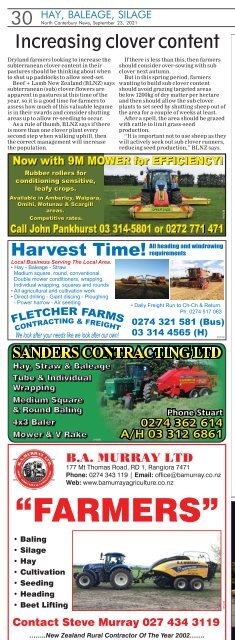North Canterbury News: September 23, 2021
Create successful ePaper yourself
Turn your PDF publications into a flip-book with our unique Google optimized e-Paper software.
HAY, BALEAGE, SILAGE<br />
30 <strong>North</strong> <strong>Canterbury</strong> <strong>News</strong>, <strong>September</strong> <strong>23</strong>, <strong>2021</strong><br />
Increasing clover content<br />
Dryland farmerslooking to increase the<br />
subterranean clovercontent in their<br />
pastures should be thinking about when<br />
to shut up paddocks to allow seedset.<br />
Beef +Lamb New Zealand (BLNZ) says<br />
subterranean (sub) clover flowers are<br />
apparent in pastures at this time of the<br />
year, so it is agood time for farmers to<br />
assesshow much of this valuable legume<br />
is in their swards and consider shutting<br />
areas up to allow reseeding to occur.<br />
As arule of thumb, BLNZ says if there<br />
is more than one cloverplant every<br />
secondstep when walking uphill, then<br />
the correct management will increase<br />
the population.<br />
Now with 9M MOWER O<br />
for EFFICIENCY!<br />
!<br />
Rubber rollers for<br />
conditioning sensitive,<br />
leafy crops.<br />
Available in Amberley, Waipara,<br />
Omihi, Motunau &Scargill<br />
areas.<br />
Competitive rates.<br />
Call John Pankhurst 03 3 314-5801 8<br />
or r 0272 771 471<br />
4<br />
Harvest Time!<br />
Local Business Serving The Local Area.<br />
• Hay -Baleage -Straw<br />
Medium square, round, conventional.<br />
Double mower conditioners, wrapping.<br />
Individual wrapping, squares and rounds<br />
• All agricultural and cultivation work<br />
• Direct drilling -Giant discing -Ploughing<br />
-Power harrow -Air seeding<br />
We look after your needs like we look after our own!<br />
Hay, Straw &Baleage<br />
& B<br />
e<br />
a<br />
g<br />
e<br />
Tube &Individual<br />
& Wrapping<br />
re &<br />
Medium Square<br />
&Round & Baling<br />
Mower 4x3 Baler<br />
&VRake<br />
Mower &VRake & V 2418266<br />
If there is less than this, then farmers<br />
should consider oversowing with sub<br />
clover next autumn.<br />
But in this spring period, farmers<br />
wanting to build sub clover content<br />
should avoid grazing targeted areas<br />
below 1200kgofdry matter per hectare<br />
and then should allowthe sub clover<br />
plants to set seed by shutting sheep out of<br />
the area for acouple of weeks at least.<br />
After aspell, the area should be grazed<br />
with cattletolimit grassseed<br />
production.<br />
‘‘It is important not to use sheep as they<br />
will actively seek out sub clover runners,<br />
reducing seed production,’’ BLNZ says.<br />
All heading and windrowing<br />
requirements<br />
• Daily Freight Run to Ch-Ch &Return.<br />
Ph: 0274 517 063<br />
0274 321 581 (Bus)<br />
03 314 4565 (H)<br />
<strong>23</strong>31792<br />
Phone Stuart<br />
0274 362 614<br />
A/H 03312 6861<br />
B.A. MURRAY LTD<br />
177 Mt Thomas Road, RD 1, Rangiora 7471<br />
Phone: 0274 343 119 | Email: office@bamurray.co.nz<br />
Web: www.bamurrayagriculture.co.nz<br />
1951439<br />
Harvest time ... There is plenty to consider with amaize crop.<br />
PHOTO: FILE<br />
Better maize results<br />
The Foundation for Arable Research<br />
(FAR) is expanding its research into<br />
the use of cover crops, following maize<br />
grain harvest, with anew cover crop<br />
research strategy.<br />
The strategy encompasses cover<br />
crop economics and how they can<br />
contribute to improving production<br />
resilience and beneficial<br />
environmental outcomes in maize<br />
grain systems.<br />
FAR maize researcher David<br />
Densley said cover crops for maize<br />
grain required quite adifferent<br />
approach to cover crops for maize<br />
silage.<br />
‘‘In maize silage, the function of a<br />
cover crop is mostly undertaken by<br />
annual ryegrass, which is sown<br />
immediately following harvest.<br />
‘‘With maize grain crops,<br />
establishment is not so easy. Many<br />
maize grain crops are not harvested<br />
until the end of April, or later, atiming<br />
which can make cover crop<br />
establishment tricky, and the amount<br />
of crop residue remaining following<br />
grain harvest presents another<br />
establishment challenge.<br />
‘‘Land that is being used to grow<br />
maize for grain has been identified as<br />
‘high risk’ for soil sediment and<br />
nitrogen loss over winter, so it’s<br />
important to look for ways to<br />
incorporate cover crops into maize<br />
grain systems to help reduce these<br />
risks.’’<br />
Cover crops can provide numerous<br />
benefits to maize and other farming<br />
systems.<br />
These include nutrient management<br />
legumes, such as faba beans or<br />
clovers, fix nitrogen as they grow and<br />
after cover crop termination, this<br />
nitrogen becomes available for use by<br />
future crops.<br />
On the other side of the scale, nonleguminous<br />
cover crops can ‘‘mop up’’<br />
nutrients left over from the previous<br />
crop, reducing the potential of nutrient<br />
losses through the soil profile.<br />
Cover crops help hold soil in place,<br />
protecting it from wind and rain<br />
erosion and can contribute to soil<br />
organic matter, which helps to improve<br />
soil structure, water infiltration, and<br />
waterholding and nutrientsupply<br />
capacity.<br />
Nongrass cover crops can<br />
contribute additional soil microbial<br />
biodiversity where maize grain is<br />
grown in amonoculture system.<br />
Cover crop roots can help to break up<br />
compacted soil layers, while the plants<br />
themselves can reduce the impact of<br />
heavy rains.<br />
Cover crop residues increase water<br />
infiltration and limit soil water<br />
evaporation, helping to reduce<br />
moisture stress in the following crop<br />
during drought conditions.<br />
Weed suppression is something else<br />
to consider, with cover crops reducing<br />
weed germination and growth during<br />
winter and spring, while some can also<br />
have an allelopathic effect on weeds.<br />
Some cover crops can be grazed<br />
provided care is taken with the grazing<br />
programme or conserved as silage<br />
before termination.<br />
Copy: Foundation for Arable<br />
Research.<br />
“FARMERS”<br />
•Baling<br />
•Silage<br />
•Hay<br />
•Cultivation<br />
•Seeding<br />
•Heading<br />
•Beet Lifting<br />
Contact Steve Murray 027 434 3119<br />
……..New Zealand Rural Contractor Of The Year 2002…….<br />
<strong>23</strong>15106<br />
ELMWOoD AG<br />
•ROUND BALING •<br />
(Mowing through to Cartage)<br />
Balage 1m -1.5m Hay 1m -1.6m<br />
•CULTIVATION •<br />
(Full Culitvation Service)<br />
6m Roller Drill &6mDirect Drill<br />
Rut Buster for HIRE<br />
2202690<br />
PHONE: Bill 027 485 8012 ~EMAIL: oxfarm@hotmail.co.nz


















